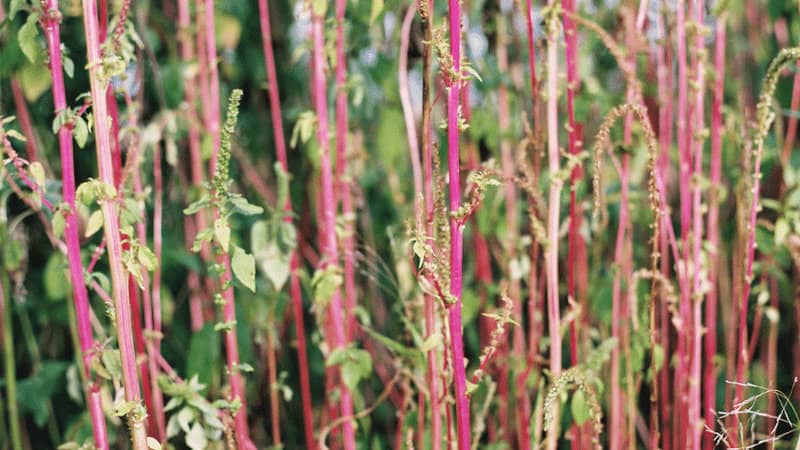
Plants with red stems and green leaves add a captivating contrast to gardens and landscapes, drawing attention with their striking color combination. In this article, we explore the allure of these botanical specimens, highlighting their unique characteristics, notable species, and landscape design possibilities.
**I. Introduction to Plants with Red Stems and Green Leaves**
Plants with red stems and green leaves create a visually stunning display in any garden setting, captivating observers with their striking color contrast. From ornamental trees to climbing vines and herbaceous perennials, these botanical specimens are prized for their aesthetic appeal and versatility in landscape design.
**II. Characteristics of Plants with Red Stems and Green Leaves**
*Botanical Features*
1. **Red Stem Pigmentation**: The red coloration of stems, often attributed to the presence of anthocyanin pigments, adds vibrancy and visual interest to plant specimens.
2. **Leaf Structure and Coloration**: Green leaves provide a complementary backdrop to red stems, enhancing the contrast and creating a dynamic focal point in the landscape.
*Environmental Adaptations*
1. **Role of Anthocyanins**: Anthocyanin pigments not only contribute to the red coloration of stems but also serve as antioxidants, protecting plants from environmental stressors such as UV radiation and temperature fluctuations.
2. **Adaptive Benefits in Various Climates**: Red-stemmed plants are often well-adapted to diverse climatic conditions, exhibiting resilience to cold temperatures and drought while thriving in full sun or partial shade.
3. **Growth Habit and Maintenance**: Depending on the species, red-stemmed plants may vary in growth habit, from compact shrubs to sprawling vines. Proper pruning and maintenance are essential to promote healthy growth and maintain desired form.
**III. Notable Species and Varieties**
*Red-Stemmed Shrubs and Trees*
1. **Japanese Maple (Acer palmatum)**: Renowned for its graceful form and vibrant foliage, Japanese maple cultivars with red stems offer year-round interest in the landscape, with stunning displays of red leaves in autumn.
2. **Red Twig Dogwood (Cornus sericea)**: This deciduous shrub is prized for its bright red stems, which provide striking contrast against the backdrop of green leaves. Red twig dogwood is often used in winter landscapes for its colorful branches.
*Herbaceous Perennials*
1. **Red-Stemmed Chard (Beta vulgaris)**: Red-stemmed chard, also known as Swiss chard, is valued for its nutritious foliage and ornamental appeal. The vibrant red stems add a pop of color to vegetable gardens and mixed borders.
2. **Red-Stemmed Malabar Spinach (Basella alba)**: A tropical vine with edible leaves, Malabar spinach features deep green foliage and vibrant red stems, making it a versatile addition to edible landscapes and trellis structures.
*Climbing Vines and Ground Covers*
1. **Red Stemmed Parthenocissus (Parthenocissus quinquefolia)**: Also known as Virginia creeper, this deciduous vine is prized for its colorful foliage and vigorous growth habit. Red stems provide striking contrast against the deep green leaves, creating a dramatic effect on trellises or walls.
2. **Red-Stemmed Bamboo (Borinda boliana)**: A clumping bamboo species with red culms, Borinda boliana adds a touch of elegance to garden landscapes. The combination of red stems and green foliage creates a captivating visual display in Asian-inspired gardens or contemporary landscapes.
**IV. Landscape Uses and Design Tips**
*Adding Visual Interest and Contrast*
1. **F
ocal Points and Accents**: Use red-stemmed plants as focal points or accents in garden beds and containers to draw attention and create visual interest.
2. **Creating Dynamic Plant Combinations**: Pair red-stemmed specimens with plants that have contrasting foliage colors or textures to create dynamic plant combinations that elevate the overall design aesthetic.
*Seasonal Appeal and Year-Round Interest*
1. **Red Stems in Winter Landscapes**: Red-stemmed plants provide vibrant color and structural interest in winter landscapes when deciduous trees and shrubs are bare.
2. **Green Leaves for Evergreen Structure**: Green foliage offers year-round structure and texture to garden landscapes, ensuring visual appeal even when red-stemmed plants are dormant.
*Maintenance Considerations*
1. **Pruning Techniques for Red Stems**: Prune red-stemmed plants as needed to maintain desired shape and size, removing any dead or damaged stems to promote healthy growth.
2. **Soil and Watering Requirements**: Provide red-stemmed plants with well-draining soil and regular watering to ensure optimal growth and vitality.
**V. Conclusion**
Enhancing your garden with plants featuring red stems and green leaves offers endless possibilities for creativity and expression in landscape design. Whether used as focal points, accents, or structural elements, these botanical specimens captivate the senses with their striking color contrast and unique aesthetic appeal. By incorporating red-stemmed plants into your garden landscapes, you can create visually stunning displays that delight the eye and inspire the soul.




